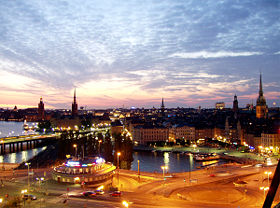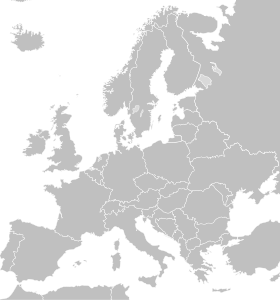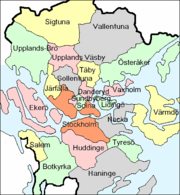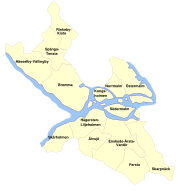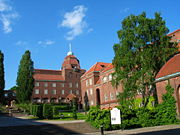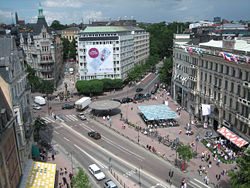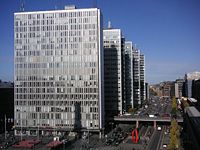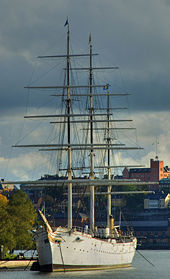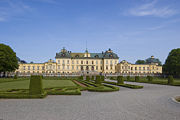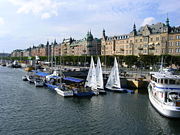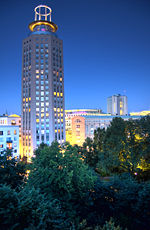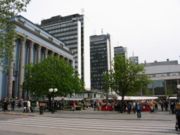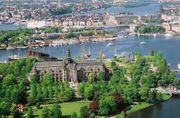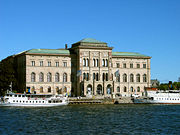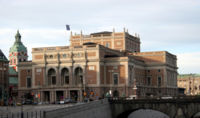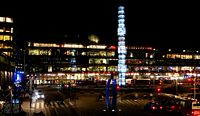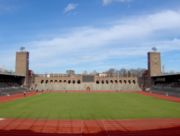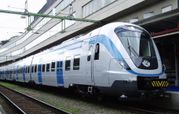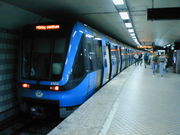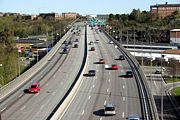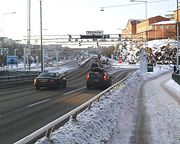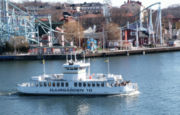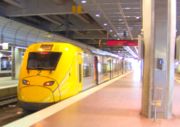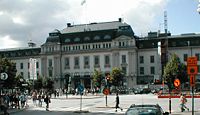Stockholm
2008/9 Schools Wikipedia Selection. Related subjects: Europe; European Cities
| City of Stockholm Stockholms stad |
|||
|
|||
| Location of Stockholm in Europe | |||
| Coordinates: | |||
|---|---|---|---|
| Country | Sweden | ||
| Municipalities |
11
|
||
| County | Stockholm County | ||
| Province | Södermanland and Uppland | ||
| First mention | 1252 | ||
| Charter | 13th century | ||
| Government | |||
| - Mayor | Sten Nordin ( m) | ||
| Area | |||
| - Urban | 377.30 km² (145.7 sq mi) | ||
| Population (2008) | |||
| - City | 798,715 ( Source: www.scb.se) | ||
| - Density | 4,230/km² (10,955.6/sq mi) | ||
| - Urban | 1,252,020 | ||
| - Urban Density | 3,318/km² (8,593.6/sq mi) | ||
| - Metro | 1,949,516 | ||
| Time zone | CET ( UTC+1) | ||
| - Summer ( DST) | CEST ( UTC+2) | ||
| Website: www.stockholm.se | |||
Stockholm (IPA: ['stɔkhɔlm]) is the largest city and capital of Sweden. It is the site of the national Swedish government, the parliament, and the official residence of the Swedish monarch.
Stockholm has been the political and economic centre of Sweden since the 13th century. Today Stockholm Municipality is the largest of the municipalities of Sweden, with a population of 795,163 (December 2007), and Stockholm urban area with a population of 1,252,020 (2005) is Sweden's largest continuously built-up area. The metropolitan area of Stockholm has a population of 1,949,516 (December 2007), thus making it the most populous city in Scandinavia. Its strategic location on several islands on the east coast of Sweden at the mouth of Lake Mälaren, by the Stockholm archipelago, has been historically important.
As of 2003, Stockholm metropolitan area is home to 21.5% of the Swedish population contributes 29.1% of Sweden's gross domestic product. 18% of residents are foreigners.
History
The location appears in Norse sagas as Agnafit, and especially in connection with the legendary king Agne. The earliest mention of Stockholm in writing dates from 1252, when the mines in Bergslagen made it an important site in the iron trade. The first part of the name (stock) means log or it may be connected to an old German word (Stock), which means fortification, while the second part of the name (holm) means islet, and is thought to refer to the islet Helgeandsholmen in central Stockholm. The city is said to have been founded by Birger Jarl in order to protect Sweden from a sea invasion by foreign navies, and to stop the pillage of towns such as Sigtuna on Lake Mälaren.
Stockholm's core, the present Old Town ( Gamla Stan) was built on the central island next to Helgeandsholmen between 1300 and 1500. The city originally rose to prominence as a result of the Baltic trade of the Hanseatic League. Stockholm developed strong economic and cultural linkages with Lübeck, Hamburg, Danzig, Visby, Reval (modern-day Tallinn) and Riga during this time. Between 1296 and 1478 Stockholm's City Council was made up of 24 members, half of whom were Hanseatic League representatives.
The strategic and economic importance of the city made Stockholm an important factor in relations between the Danish Kings of the Kalmar Union and the national independence movement in the 15th century. The Danish King Christian II was able to enter the city in 1520. On November 8, 1520, massive executions of opposition figures, called the Stockholm Bloodbath, took place. This massacre set off further uprisings, which eventually led to the break-up of the Kalmar Union. With the accession of Gustav Vasa in 1523 and the establishment of a royal power, the population of Stockholm began to grow, reaching ten thousand by 1600.
The 17th century saw Sweden rise into a major European power, reflected in the development of the city of Stockholm. From 1610 to 1680, the population multiplied sixfold. In 1634, Stockholm became the official capital of the Swedish empire. Trading rules were also created that gave Stockholm an essential monopoly over trade between foreign merchants and other Swedish and Scandinavian territories.
Between 1713–1714, Stockholm suffered from the Black Death. After the end of the Great Northern War and the destruction of several areas of the city in 1721, the city stagnated. Population growth halted and economic growth slowed. However, Stockholm maintained its role as the political centre of Sweden and continued to develop culturally under Gustav III. The royal opera is a good architectural example of this era.
By the second half of the 19th century, Stockholm had regained its leading economic role. New industries emerged, and Stockholm transformed into an important trade and service centre, as well as a key gateway point within Sweden. The population also grew radically during this time, mainly through immigration. At the end of the century, less than 40% of the residents were Stockholm-born. Settlement began to expand outside of the city limits. In the 19th century, a number of scientific institutes opened in Stockholm, including the Karolinska Institute, and the General Art and Industrial Exposition was held in 1897.
During the latter half of the 20th century, Stockholm became a modern, technologically-advanced, and ethnically diverse city. Many historical buildings were torn down, including the entire historical district of Klara, and replaced with modern architecture. Throughout the century, many industries shifted away from work-intensive activities into more high-technology and service-industry areas.
The city continued to expand and new districts were created, such as Rinkeby, and Tensta, some with high proportions of immigrants.
Geography
Location
Stockholm is located on Sweden's east coast, where Lake Mälaren meets the Baltic Sea. The central parts of the city consist of fourteen islands, all part of the archipelago. The geographical city centre is situated on the water, in the bay Riddarfjärden.
For details about the other municipalities usually considered part of Stockholm, see the municipality in question. North of Stockholm Municipality: Järfälla, Solna, Täby, Sollentuna, Lidingö, Upplands Väsby, Österåker, Sigtuna, Sundbyberg, Danderyd, Vallentuna, Ekerö, Upplands-Bro, Vaxholm, and Norrtälje. South of Stockholm: Huddinge, Nacka, Botkyrka, Haninge, Tyresö, Värmdö, Södertälje, Salem, Nykvarn and Nynäshamn.
Stockholm Municipality
Stockholm Municipality is an administrative unit defined by geographical borders. The semi-officially adopted name for the municipality is City of Stockholm (Stockholms stad in Swedish). As a municipality, the City of Stockholm is subdivided into district councils, which carry responsibility for primary schools, social, leisure and cultural services within their respective areas. The City of Stockholm is usually described in terms of its three main parts: Stockholm City Centre (Innerstaden), South Stockholm (Söderort) and West Stockholm (Västerort). The districts of these parts are:
| Stockholm City Centre | South Stockholm | West Stockholm |
|---|---|---|
|
|
|
Climate
Stockholm has a humid continental climate according to the Köppen climate classification. Due to the city's high northern latitude, the climate of Stockholm is extremely varied, with four distinct seasons and pretty mild throughout the year, mainly because of the Gulf stream. During the summer, it has 18 hours of daylight, in winter only around 6 hours. The city has over 1,800 hours of sunshine every year.
Summers are warm with average high temperatures of 22°C (72°F) and lows of 13°C (55°F). Winters are cold with average temperatures just below freezing. Both spring and fall are cool, or sometimes warm. High temperatures of 25°C (77°F) or warmer occurs on average 16 days each summer.
Yearly average precipitation is 539 mm (21.2 inches) with light rainfall throughout the year, but winters tends to be somewhat drier than other seasons. Snowfall normally occurs from November to the end of April, with 16 snowy days each winter season, but some winters tends to be mostly free of snow.
Typical temperatures and precipitation for each month:
| Weather averages for Stockholm | |||||||||||||
|---|---|---|---|---|---|---|---|---|---|---|---|---|---|
| Month | Jan | Feb | Mar | Apr | May | Jun | Jul | Aug | Sep | Oct | Nov | Dec | Year |
| Average high °C (°F) | -1 (30) | -1 (30) | 3 (37) | 9 (48) | 16 (61) | 21 (70) | 22 (72) | 20 (68) | 15 (59) | 10 (50) | 5 (41) | 1 (34) | 10 (50) |
| Average low °C (°F) | -5 (23) | -5 (23) | -3 (27) | 1 (34) | 6 (43) | 11 (52) | 13 (55) | 13 (55) | 9 (48) | 5 (41) | 1 (34) | -3 (27) | 3 (38) |
| Precipitation mm (inches) | 39 (1.54) | 27 (1.06) | 26 (1.02) | 30 (1.18) | 30 (1.18) | 45 (1.77) | 72 (2.83) | 66 (2.6) | 55 (2.17) | 50 (1.97) | 53 (2.09) | 46 (1.81) | 539 (21.22) |
| Source: World Weather Information Service 2008-01-06 | |||||||||||||
Politics and government
Municipalities are responsible for government-mandated duties, and elections for the Municipal council are held every four years, parallel to the general elections.
Following the 2006 municipal elections, the seats are divided in the following way:
| The governing parties | Parties in opposition |
|---|---|
|
|
The Mayor of Stockholm is as of April 2008 Sten Nordin from the Moderate Party.
Economy
The vast majority of Stockholmians work in the service industry, which accounts for roughly 85% of jobs in Stockholm. The almost total absence of heavy industry makes Stockholm one of the world's cleanest metropolises. he last decade has seen a significant number of jobs created in high technology companies. Large employers include IBM, Ericsson, and Electrolux. A major IT centre is located in Kista, in northern Stockholm.
Stockholm is Sweden's financial centre. Major Swedish banks, such as Swedbank, Handelsbanken, and Skandinaviska Enskilda Banken, are headquartered in Stockholm, as are the major insurance companies Skandia and Trygg-Hansa. Stockholm is also home to Sweden's foremost stock exchange, the Stockholm Stock Exchange (Stockholmsbörsen). Finally, about 45% of Swedish companies with more than 200 employees are headquartered in Stockholm. Famous clothes retailer H&M is also headquartered in the city. In the last years, tourism has played an important part in the city's economy. Between 1991–2004, annual overnight stays increased from 4 to 7.7 million.
Largest companies by number of employees:
- Ericsson – 8,430
- Posten – 4,710
- Skandinaviska Enskilda Banken (SEB) – 4,240
- Swedbank – 3,610
- Södersjukhuset (Southern Hospital) – 3,610
- Nordea – 2,820
- Handelsbanken – 2,800
- IBM Svenska – 2,640
- Capgemini – 2,500
- Securitas – 2,360
- Connex – 2,300
- ISS Facility Services – 2,000
- Sveriges Television (public television) – 1,880
- Sodexho – 1,580
Education
Research and higher education in the sciences started in Stockholm in the 18th century, with an education in medicine and various research institutions, such as the Stockholm Observatory. The medical education was eventually formalized in 1811 as the Karolinska Institutet. The Royal Institute of Technology (Kungliga Tekniska Högskolan, or KTH) was founded in 1827 and is currently Scandinavia's largest higher education institute of technology with 13,000 students. Stockholm University, founded in 1878 with university status granted in 1960, has 52,000 students as of 2008. It also incorporates many historical institutions, such as the Observatory, the Swedish Museum of Natural History, and the botanical garden Bergianska trädgården. The Stockholm School of Economics, founded in 1909, is one of few private institutions of higher education in Sweden.
In the fine arts, educational institutions include the Royal College of Music, which has a history going back to the conservatory founded as part of the Royal Swedish Academy of Music in 1771, the Royal University College of Fine Arts, which has a similar historical association with the Royal Swedish Academy of Arts and a foundation date of 1735, and the Swedish National Academy of Mime and Acting, which is the continuation of the school of the Royal Dramatic Theatre, once attended by Greta Garbo. Other schools include the design school Konstfack, founded in 1844, the University College of Opera (founded in 1968, but with older roots), the University College of Dance, and the Stockholms Musikpedagogiska Institut (the University College of Music Education).
The Södertörn University College was founded in 1995 as a multidisciplinary institution for southern Metropolitan Stockholm, to balance the many institutions located in the northern part of the region.
Other institutes of higher education are:
- Military Academy Karlberg, the world's oldest military academy to remain in its original location, inaugurated in 1792 and housed in Karlberg Palace.
- Ersta Sköndal University College
- The Stockholm School of Theology (Teologiska Högskolan, Stockholm)
- The Swedish School of Sport and Health Sciences ( Gymnastik- och idrottshögskolan, or GIH)
- The Stockholm Institute of Education (Lärarhögskolan i Stockholm)
Demographics
The Stockholm region is home to around 20% of Sweden's total population, and accounts for about 25% of the gross domestic product. The geographical notion of "Stockholm" has changed throughout the times. By the turn of the 19th century, Stockholm basically consisted of the area today known as City Centre, roughly 35 km² (14 sq mi) or 1/5 of the current municipal area. In the ensuing decades several other areas were incorporated (such as Brännkyrka Municipality in 1913, at which time it had 25,000 inhabitants, and Spånga in 1949). The municipal border was established in 1971 – with the exception of Hansta, in 1982 purchased by Stockholm Municipality from Sollentuna Municipality and today a nature reserve.
Of the population of 765,044 (2004), 370,482 were men and 394,562 women. The average age is 39.8 years; 40.5% of the population is between 20 and 44 years. 309,480 people, or 40.4% of the population, over the age 15 were unmarried. 211,115 people, or 27.5% of the population, were married. 85,373, or 11.1% of the population, had been married but divorced.
Historical population
Population in the City of Stockholm from 1750 to present:
| Year | Stockholm | Nationwide | Stockholm % of nation |
|---|---|---|---|
| 1750 | 60,018 | 1,780,678 | 3.4 |
| 1800 | 75,517 | 2,347,303 | 3.2 |
| 1850 | 93,070 | 3,482,541 | 2.7 |
| 1900 | 300,624 | 5,136,441 | 5.9 |
| 1910 | 342,323 | 5,522 403 | 6.2 |
| 1920 | 419,440 | 5,904,489 | 7.1 |
| 1930 | 502,213 | 6,142,191 | 8.2 |
| 1940 | 590,503 | 6,371,432 | 9.3 |
| 1950 | 744,143 | 7,041,829 | 10.6 |
| 1960 | 808,294 | 7,500,161 | 10.8 |
| 1970 | 740,486 | 8,091,782 | 9.2 |
| 1980 | 647,214 | 8,317,937 | 7.8 |
| 1985 | 659,030 | 8,358,139 | 7.9 |
| 1990 | 674,452 | 8,590,630 | 7.9 |
| 1995 | 711,119 | 8,837,496 | 8.0 |
| 2000 | 750,348 | 8,882,792 | 8.4 |
| 2005 | 771,038 | 9,047,752 | 8.5 |
| 2007 | 788,269 | 9,127,058 | 8.6 |
In the last century, the population of nearby municipalities in Stockholm County has become relevant to mention as well as the population of Stockholm Municipality, as many municipalities form part of the Stockholm urban area and as such are often considered part of the general term "Stockholm".
As of 2000, Stockholm urban area extended into 11 municipalities (Stockholm Municipality 750,000 inh.; Huddinge 82,891; Järfälla 60,254; Solna 56,605; Sollentuna 53,715; Botkyrka 48,268; Haninge 40,151; Tyresö 36,483; Sundbyberg 33,868; Nacka 25,170; Danderyd 24,600) and a total population of 1,200,000 inhabitants. In the entire Stockholm County, with its 26 municipalities, the population reaches 1,900,000 inhabitants.
Culture
Apart from being a large city with an active cultural life, Stockholm, as Sweden's capital, houses many national cultural institutions. There are three UNESCO World Heritage sites in the Stockholm area: the Royal Palace Drottningholm (within Ekerö Municipality), Birka and Hovgården (also within Ekerö) and the Skogskyrkogården (The Woodland Cemetery).
Stockholm was the 1998 European City of Culture.
Literature
Authors connected to Stockholm include the poet and songwriter Carl Michael Bellman (1740–1795), novelist and dramatist August Strindberg (1849–1912), and novelist Hjalmar Söderberg (1869–1941), all of whom made Stockholm part of their works. Other authors with notable heritage in Stockholm were the Nobel Prize laureate Eyvind Johnson (1900–1976) and the popular poet and composer Evert Taube (1890–1976). The novelist Per Anders Fogelström (1917–1998) wrote a popular series of historical novels depicting life in Stockholm from the 19th to the mid-20th century.
Architecture
The city's oldest section is “ Gamla Stan” (Old Town), located on the original small islands of the city's earliest settlements and still featuring the medieval street layout. Some notable buildings of Gamla Stan are the large German Church (Tyska kyrkan) and several mansions and palaces: the Riddarhuset (the House of Nobles), the Bonde Palace, the Tessin Palace and the Oxenstierna Palace. The oldest building in Stockholm is the Riddarholmskyrkan from the late 13th century. After a fire in 1697 when the original medieval castle was destroyed, Stockholm Palace was erected in a baroque style. Storkyrkan Cathedral, the episcopal seat of the Bishop of Stockholm, stands next to the castle. It was founded in the 13th century but is clad in a baroque exterior dating to the 18th century.
As early as the 15th century, the city had expanded outside of its original borders. Some pre-industrial, small-scale buildings from this era can still be found in Södermalm. During the 19th century and the age of industrialization Stockholm grew rapidly, with plans and architecture inspired by the large cities of the continent such as Berlin and Vienna. Notable works of this time period include public buildings such as the Royal Swedish Opera and private developments such as the luxury housing developments on Strandvägen.
In the 20th century, a nationalistic push spurred a new architectural style inspired by medieval and renaissance ancestry as well as influences of the Jugend / Art Nouveau style. A key landmark of Stockholm, the Stockholm City Hall, was erected 1911–1923 by architect Ragnar Östberg. Other notable works of these times are the Stockholm Public Library and the Forest Cemetery, Skogskyrkogården
In the 1930s modernism characterized the development of the city as it grew. New residential areas sprang up such as the development on Gärdet while industrial development added to the growth, such as the KF manufacturing industries on Kvarnholmen located in the Nacka Municipality. In the 1950s, suburban development entered a new phase with the introduction of the Stockholm metro. The modernist developments of Vällingby and Farsta were internationally praised. In the 1960s this suburban development continued but with the aesthetic of the times, the industrialised and mass-produced blocks of flats received a large amount of criticism.
At the same time that this suburban development was happening the most central areas of the inner city were being redesigned. Sergels Torg, with its five high-rise office towers was created in the 1960s, followed by the total clearance of large areas to make room for new development projects. The most notable buildings from this period is the ensemble of the House of Culture, City Theatre and National Bank at Sergels Torg, designed by architect Peter Celsing.
Museums
Stockholm is one of the most crowded museum-cities in the world with around 100 museums, visited by millions of people every year. The most renowned national museum is the Nationalmuseum, with Sweden's largest collection of art: 16,000 paintings and 30,000 objects of art handicraft. The collection dates back to the days of Gustav Vasa in the 16th century, and has since been expanded with works by artists such as Rembrandt, and Antoine Watteau, as well as constituting a main part of Sweden's art heritage, manifested in the works of Alexander Roslin, Anders Zorn, Johan Tobias Sergel, Carl Larsson, Carl Fredrik Hill and Ernst Josephson.
The Museum of Modern Art, or Moderna Museet, is Sweden's national museum of modern art. It has works by famous modern artists such as Picasso and Salvador Dalí.
Other notable museums:
- Stockholm City Museum
- Skansen, the archetype of open air museums, inaugurated 1891.
- Nordic Museum, dedicated to the cultural history and ethnography of Sweden.
- The Vasa Museum, now with the reconstruction of the missing parts of the Vasa Ship.
Outer suburbs
The outer Stockholm suburbs are places with diverse cultural background. Some areas in the outer suburbs, including those of Tensta, Jordbro, Fittja, Husby, Rinkeby, Kista, Hagsätra, Rågsved, Södertälje, Huddinge, have high percentages of immigrants or second generation immigrants. These mainly come from the Middle East and former Yugoslavia but there are also immigrants from Africa, Southeast Asia and Latin America. Other parts of the outer suburbs, such as Hässelby, Vällingby, Flysta and Hökarängen, as well as some of the suburbs mentioned above, have a majority of ethnic Swedes.
Theatres
Distinguished among Stockholm's many theatres are the Royal Dramatic Theatre (Dramaten), one of Europe's most renowned theatres, and the Royal Swedish Opera, inaugurated in 1773.
Other notable theatres are the Stockholm City Theatre (Stockholms stadsteater), the Peoples Opera ( Folkoperan), the Modern Theatre of Dance (Moderna dansteatern), the China Theatre, the Göta Lejon Theatre, the Mosebacke Theatre, and the Oscar Theatre.
Amusement Park
Gröna Lund is an amusement park located on the island of Djurgården. It is open from end of April to middle of September and also opens during Christmas for market. Gröna Lund also serves as a concert venue.
Sports
The most popular spectator sports are football and ice hockey. The three most popular teams are AIK, Djurgårdens IF and Hammarby IF.
Historically, the city was the host of the 1912 Summer Olympics. From those days stem the Stockholms Olympiastadion which has since hosted numerous sports events, notably football and athletics. Other major sport arenas are Råsunda Stadium, the national football stadium, and Stockholm Globe Arena, a multi-sport arena and one of the largest spherical buildings in the world.
Stockholm also hosted all but one of the Nordic Games, a winter multi-sport event that predated the Winter Olympics.
Yearly events
- Stockholm Jazz Festival is one of Sweden's oldest festivals. The festival takes place at Skeppsholmen in July.
- Stockholm Pride is the largest Pride event in the Nordic countries and takes place in the last week of July every year. The Stockholm Pride always ends with a parade and in 2007, 50 000 people marched with the parade and about 500 000 watched it.
- The Stockholm Marathon takes place on a Saturday in early June each year
- The Nobel Banquet takes place at Stockholm City Hall every year on December 10
Transport
Public transport
Stockholm has an extensive public transport system. It consists of the Stockholm Metro (Tunnelbana); three regional/suburban rail systems: commuter rail (pendeltåg), Roslagsbanan, and Saltsjöbanan; three light rail systems: Nockebybanan, Lidingöbanan, and Tvärbanan; a large number of bus lines, and an inner-city boat line. All the land-based public transport in Stockholm County, except the airport buses/trains, are organized by Storstockholms Lokaltrafik (SL), with the operation and maintenance of the public transport services delegated to several contractors, such as Veolia Transport who operate the metro and regional/suburban railways except for the commuter rail. The archipelago boat traffic is handled by Waxholmsbolaget.
SL has a common ticket system in the entire Stockholm County, which allows for easy travel between different modes of transport. The tickets are of two main types, single ticket and travel cards, both allowing for unlimited travel with SL in the entire Stockholm County for the duration of the ticket validity. Starting April 1st, 2007, a new zone system(A,B,C) and price system applies for single tickets. Single tickets are now available in forms of cash ticket, individual unit pre-paid tickets, pre-paid ticket slips of 10, sms-ticket and machine ticket. Cash tickets bought at the point of travel are the most expensive and pre-paid tickets slips of 10 are the cheapest. A single ticket is valid for one hour. The duration of the travel card validity depends on the exact type, they are available from 24 hours up to a year. A 30-day card costs 690 SEK (73 EUR; 115 USD). Tickets of all these types are available with reduced price for persons under 20 and over 65 years old.
Roads
Stockholm is at the junction of the European routes E4, E18 and E20. A half-completed motorway ring road exists on the south and west sides of the City Centre.
Congestion charges
Stockholm has a congestion pricing system, Stockholm congestion tax, in use on a permanent basis since August 1, 2007, after having had a seven month trial period in the first half of 2006. The City Centre is within the congestion tax zone. All the entrances and exits of this area have unmanned control points operating with automatic number plate recognition. All vehicles entering or exiting the congestion tax affected area, with a few exceptions, have to pay 10–20 SEK (1.09–2.18 EUR, 1.49–2.98 USD) depending on the time of day between 06:30 and 18:29. The maximum tax amount per vehicle per day is 60 SEK (6.53 EUR, 8.94 USD). Payment is done by various means within 14 days after one has passed one of the control points, one cannot pay at the control points.
After the trial period was over, consultative referendums were held in Stockholm Municipality and several other municipalities in Stockholm County. The then-reigning government ( cabinet Persson) stated that they would only take into consideration the results of the referendum in Stockholm Municipality. The opposition parties ( Alliance for Sweden) stated that if they were to form a cabinet after the general election—which was held the same day as the congestion tax referendums—they would take into consideration the referendums held in several the other municipalities as well, but didn't specify more in detail how they would do that. The results of the referendums were that the Stockholm Municipality voted for the congestion tax, but all the other municipalities voted against it. The opposition parties won the general election and a few days before they formed government ( cabinet Reinfeldt) they announced that the congestion tax would be reintroduced in Stockholm, but that the revenue would go entirely to road construction in and around Stockholm. During the trial period and according to the agenda of the previous government the revenue went entirely to public transport.
Ferries
Stockholm has regular ferry lines to Helsinki and Turku in Finland (commonly called " Finlandsfärjan"); Tallinn, Estonia; Riga, Latvia; and to the Åland islands. Travelers are no longer able to take a direct ferry to St. Petersburg, Russia as of 1998. One must first ferry to Helsinki and then onto St. Petersburg.
The large Stockholm archipelago is served by the Waxholmsbolaget archipelago boats.
Airports
Stockholm-Arlanda Airport is the largest and busiest airport in Sweden with 18 million passengers in 2007. It is located about 40 km north of Stockholm.
- International and domestic:
- Stockholm-Arlanda Airport is the primary airport for the region and serves as a hub for Scandinavian Airlines.
- Stockholm-Bromma Airport
- Only international:
- Stockholm-Skavsta Airport is located 100 km (62.5 miles) south of Stockholm.
- Stockholm-Västerås Airport is located 110 km (68 miles) west of Stockholm, in the city of Västerås.
Flygbussarna bus lines run to and from central Stockholm from all the airports, and the Arlanda Express airport rail link runs between Arlanda Airport and Stockholm.
Inter-city trains
The Stockholm Central Station has train connections to many Swedish towns, and to Oslo and Copenhagen. The popular X2000-service to Gothenburg takes three hours. Most of the trains are run by SJ AB.
Twin towns
The policy of Stockholm is to have informal town twinning with all capitals of the world, its main focus being those in northern Europe. Stockholm does not sign any formal town twinning treaties, although the city claims to have established such treaties in the past which are still valid.
The cities claiming to have been twinned with Stockholm are:
 Tirana, Albania
Tirana, Albania Kiev, Ukraine
Kiev, Ukraine Cali, Colombia
Cali, Colombia Sarajevo, Bosnia Herzegovina
Sarajevo, Bosnia Herzegovina St. Petersburg, Russia
St. Petersburg, Russia Istanbul, Turkey
Istanbul, Turkey Podgorica, Montenegro
Podgorica, Montenegro Reykjavik, Iceland
Reykjavik, Iceland
